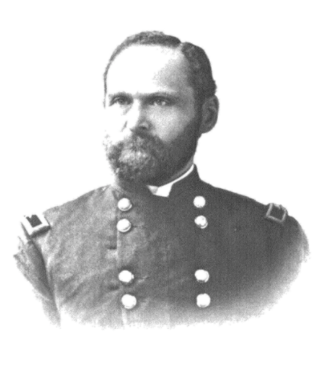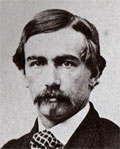
Thomas Howard Ruger was an American soldier and lawyer who served as a Union general in the American Civil War. After the war, he was a superintendent of the United States Military Academy at West Point, New York.

Amasa Cobb was an American politician and judge. He was the 6th and 9th Chief Justice of the Nebraska Supreme Court and the 5th Mayor of Lincoln, Nebraska. Earlier in his life, he was a United States Congressman from Wisconsin for 8 years and served as the 13th Speaker of the Wisconsin State Assembly. He also served as a Union Army officer during the American Civil War.

Abram Duryée was a Union Army general during the American Civil War, the commander of one of the most famous Zouave regiments, the 5th New York Volunteer Infantry. After the war he was New York City Police Commissioner.

The African American Civil War Memorial Museum, in the U Street district of Washington, D.C., recognizes the contributions of the 209,145 members of the United States Colored Troops (USCT). The eponymous memorial, dedicated in July 1998 by the African American Civil War Memorial Freedom Foundation, commemorates the service of 209,145 African-American soldiers and about 7,000 white and 2,145 Hispanic soldiers, together with the approximate 20,000 unsegregated Navy sailors, who fought for the Union in the American Civil War, mostly among the 175 regiments of United States Colored Troops.

Henry Clay Pleasants was a coal mining engineer and an officer in the Union Army during the American Civil War. He is best known for organizing the building of a tunnel filled with explosives under the Confederate lines outside Petersburg, Virginia, which resulted in the Battle of the Crater on July 30, 1864. The Union troops, however, failed in their opportunity to break the Siege of Petersburg.

Aaron Simon Daggett was a career United States Army officer. He was the last surviving brevet Union general of the American Civil War, and the last surviving general of any grade from the war, when he died exactly one month shy of his 101st birthday in 1938. Daggett was nominated for appointment to the grade of brevet brigadier general, to rank from March 13, 1865, by President Andrew Johnson on February 21, 1866 and was confirmed by the United States Senate on April 10, 1866. During the war, Daggett fought at West Point, Gaines' Mill, Golding's Farm, White Oak Swamp, Second Bull Run, South Mountain, Antietam, Rappahannock Station, Fredericksburg, Battle of Gettysburg, Battle of Mine Run, Battle of the Wilderness and Battle of Cold Harbor. Daggett was a brigadier general of volunteers in the Spanish–American War. He was appointed to the brigadier general grade to rank from September 1, 1898 and was mustered out of the volunteers on November 30, 1898. He was promoted to brigadier general in the Regular Army ten days before his retirement from the army on March 2, 1901.
The 3rd Wisconsin Infantry Regiment was an infantry regiment that served in the Union Army during the American Civil War.

Charles Kinnaird Graham was a sailor in the antebellum United States Navy, attorney, and later a brigadier general in the Union Army during the American Civil War. As a civil engineer, he helped plan and lay out Central Park in New York City.

Thomas Worcester Hyde was an American Union Army colonel, a state senator from Maine, and the founder of the Bath Iron Works, one of the major shipyards in the United States. He wrote two books about his experiences during the American Civil War and at the Battle of Gettysburg.

Charles Sawyer Russell was a United States Army officer in the Union Army during the American Civil War.
Reuben D. Mussey Jr. was a Union Army colonel during the American Civil War and a distinguished lawyer. He was an important recruiter of black men into the United States Colored Troops. Between April 1865 and November 1865, Mussey was President Andrew Johnson's private secretary. Johnson nominated Mussey for appointment to the brevet grade of brigadier general of volunteers, but the U.S. Senate did not confirm the appointment. Mussey was the husband of Ellen Spencer Mussey who was also his law partner and became the head of the practice upon his death.

George Washington Bowie, was a Union Army officer during the American Civil War, commanding the 5th Regiment California Volunteer Infantry and being brevetted Brigadier General of Volunteers.
Elias Wright was a Union Army officer during the American Civil War.

The 35th Massachusetts was an infantry regiment that served in the Union Army during the American Civil War.

James Monroe Williams was an American lawyer, soldier, and merchant. He served both as a cavalry and as an infantry officer in the Union Army within the Trans-Mississippi Theater during the American Civil War, and was breveted a brigadier general near the end of the conflict.

Daniel Tompkins Van Buren was an American military officer and engineer. He attained the rank of brigadier general by brevet as a member of the Union Army during the American Civil War.

William Sterling King was an American officer in the Union Army during the American Civil War, twice elected to the Massachusetts legislature, and was the first Chief Constable of the then-Massachusetts State Constabulary.

Herbert Bradwell Titus was an American Army officer. He was a Union brevet brigadier general during the period of the American Civil War. He received his appointment as brevet brigadier general dated to March 13, 1865. During much of the war, Titus served as a colonel with the 9th New Hampshire Volunteer Infantry.

Charles Swain Lovell (1811-1871) was an American military officer and Brevet Brigadier General who commanded a brigade during several major battles of the American Civil War.

Joseph Henry Barnes (1833-1906) was an American Brevet Brigadier General who commanded the 29th Massachusetts Infantry Regiment during the Eastern Theater of the American Civil War.

















